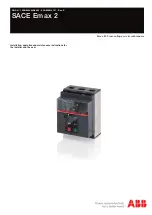
ABB | SACE Emax 2
156 | © 2017 ABB | 1SDH001330R0002 - ECN000058721 Rev. A
Specific applications | 1 - Zone Selectivity
Specific applications
1 - Zone Selectivity
Description
Zone Selectivity is an evolution of time selectivity (see chapter "2 - Selectivity between ABB SACE circuit-
breakers"), in which a dialog is created between the trip units through input and output blocking signals: an
active input blocking signal means that the circuit-breaker must remain closed.
Specifically, if a trip unit with the function enabled detects a fault current higher than the threshold set for a
particular protection, it activates the output blocking signal for the protection and, before opening, checks
the corresponding input blocking signal:
• If the input is not active, the trip unit opens with a delay equal to the selectivity time set for the protection
(which must be lower than the protection tripping time).
• If the input is active, it opens only if the fault persists and with a delay equal to the tripping time of the
protection.
With ABB SACE circuit-breakers (other than Emax 2), Zone Selectivity can only be implemented for
protections S G and D, through wiring. For further information, see the paragraph "Zone Selectivity with ABB
SACE circuit-breakers".
With SACE Emax 2 circuit-breakers, Zone Selectivity can also be implemented for protections S2 and Gext
using Link Bus communication between trip units equipped with an Ekip Link module. For further information,
see the paragraph “Zone Selectivity with SACE Emax 2 circuit-breakers".
Zone Selectivity with ABB SACE
circuit-breakers
With electronic trip units not for ABB SACE Emax 2:
• Zone selectivity can be implemented only for protections S G and D (Directional).
• If the function is available, the circuit-breaker is equipped with two blocking outputs and two blocking
inputs that is, one output and one input for each S and G protection), or as an alternative two outputs
and two inputs for protection D (one output and one input per direction).
• Since only two blocking outputs and two blocking inputs are available, Zone Selectivity for protections S
and G and Directional Zone Selectivity are mutually excluding (to implement Directional Zone Selectivity,
the S and G protections must be disabled, and vice versa).
• To implement Zone Selectivity, the trip units must be supplied with auxiliary voltage to activate the blocking
outputs, and for each S G and D protection, two parameters need to be set (the parameter for enabling
the function, and the selectivity time within which the circuit-breaker must open if the blocking input is not
active and before the protection trips).
• The blocking outputs and inputs are considered active if the level is high (equal to the auxiliary voltage).
• For protection D, the selectivity time to be set is the same for both directions.
To obtain Zone Selectivity, the protections must be set, and the blocking outputs and must be wired, so that
only those circuit-breakers capable of isolating the overload or fault without the rest of the installation being
de-energized open. Regarding this:
• For each type of selectivity, definitions, operating principles, application fields, advantages and disadvantages,
requirements, indications for setting the protections and examples are provided in the Technical Application
Paper QT1
"Low voltage selectivity with ABB circuit-breakers".
• For Directional Selectivity, application examples are available in the White Paper
“Directional protection and directional zone selectivity”.
Summary of Contents for SACE Emax E1.2
Page 2: ...ABB SACE Emax 2 2 2017 ABB 1SDH001330R0002 ECN000058721 Rev A ...
Page 8: ...VI 2017 ABB SACE Emax 2 1SDH001330R0002 ECN000058721 Rev A ...
Page 9: ...ABB SACE Emax 2 3 2017 ABB 1SDH001330R0002 ECN000058721 Rev A ...
Page 310: ...ABB SACE Emax 2 304 2017 ABB 1SDH001330R0002 ECN000058721 Rev A Service 1 Power Care ...





































